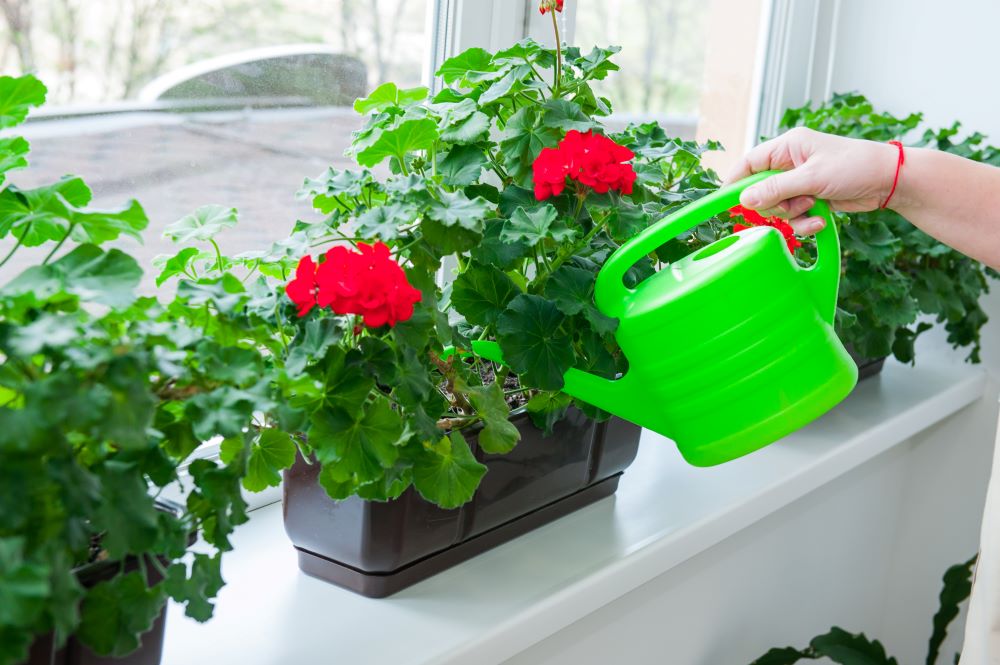5 Container Gardening Tips For Pots & Planters
Whether you’re a pro or beginner gardener, planting in containers can be an easy way to add some beautiful flowers and plants to your space. When it comes to container gardening, there are so many different types of planters and various types of flowers that you can use. Planting in containers also gives you the flexibility to plant indoors or outdoors, depending on the plants that you choose. Here are 5 simple and easy container gardening tips for pots and planters.
1. Choose Pots & Planters With Proper Drainage
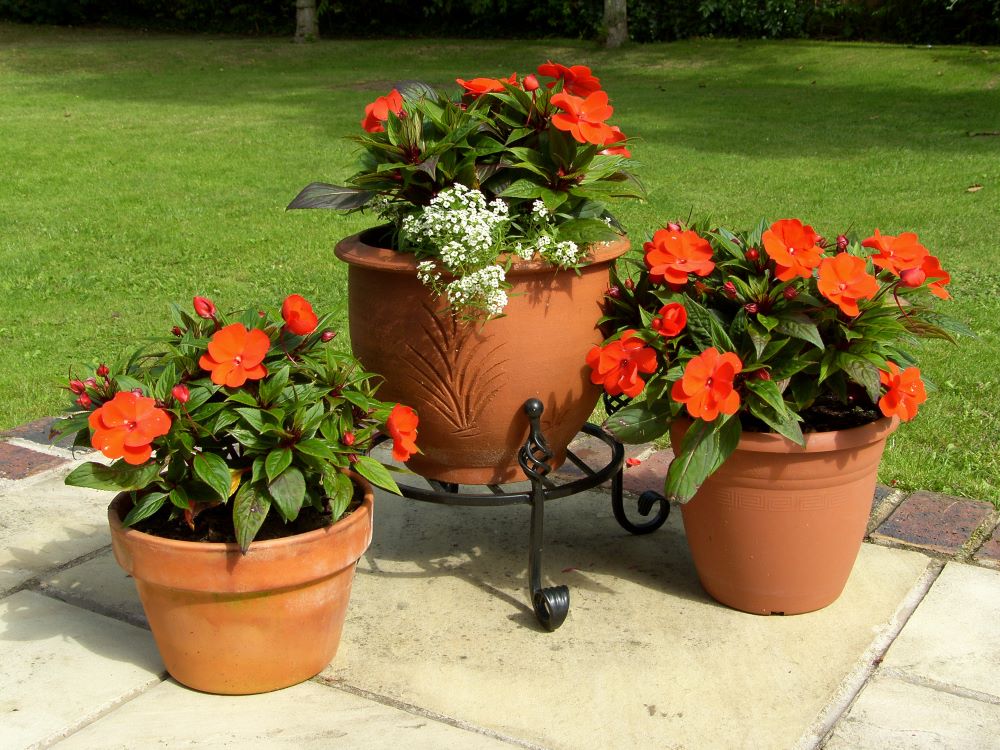
The first step in starting container gardening is to carefully choose the pots and planters you want to use. While you probably want to consider the design and appearance of the planters to display in your yard or inside your home, it’s also important to consider the practicality of the containers. In order to maintain healthy plants and flowers, they have to live in proper containers.
One of the main things to consider when choosing a container is drainage. Planters with proper drainage holes on the bottom will allow water to easily flow through. Roots will rot if they’re left in soggy soil, so it’s highly important to choose the right container. If you choose a unique planter that doesn’t have drainage holes, you can even drill your own holes as long as they’re big enough.
Types Of Pots & Planters
Terra-Cotta Pots
These types of pots are one of the most common, and there are so many different colors and sizes to choose from. The materials in these pots helps keeps soil cool, allowing for healthier plant roots. Glazed terra-cotta pots can retain even more water and are highly effective.
Plastic Nursery Pots
Plastic pots are the perfect choice if you aren’t too focused on the visual design of your garden. These types of pots retain moisture very well and are incredibly durable. They’re also lightweight, which makes them easier to move around to different areas.
Concrete Planters
Concrete planters are great for larger plants because they’re heavy and secure. The concrete material provides great insulation for the soil, giving the ideal environment for plant roots. While these are heavy to move, concrete planters are capable of being outside all year long without being harmed, even through a cold winter.
Wood Planters
Lightweight and decorative in appearance, wood planters are also very practical for gardening. They retain water very well, providing a healthy environment for plants. Just make sure to choose rot-resistant wood such as cedar and redwood.
If you’re crafty, you can even make your own planters for a personal touch. Check out these 5 Creative DIY Flower Pots & Planters To Make This Spring!
2. Pick The Best Types Of Plants & Flowers For Containers
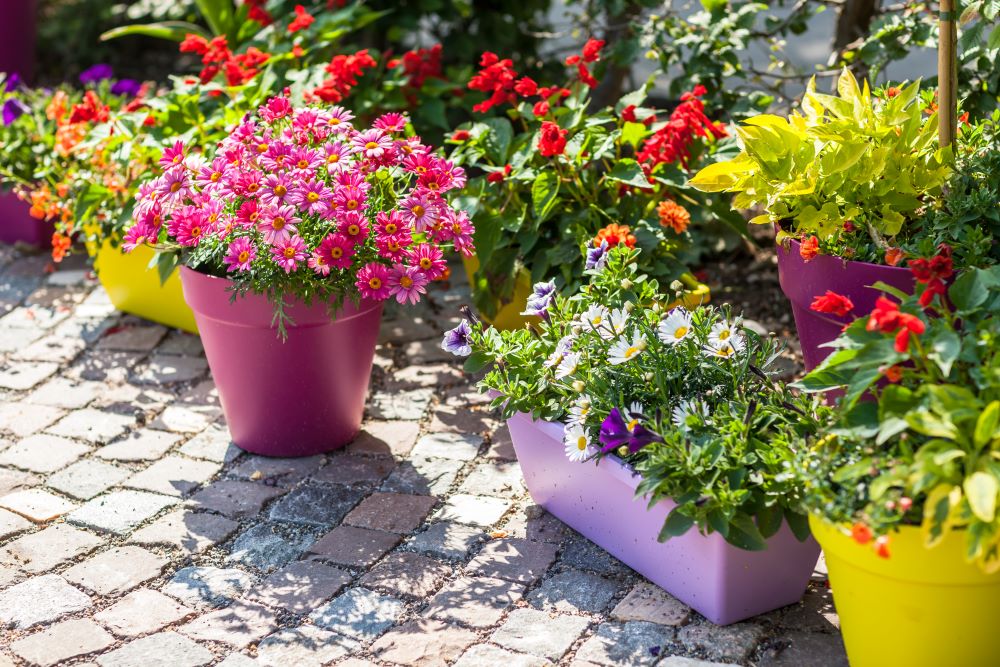
Once you decide on the types of pots and planters you want to use, you also have to put a lot of care and consideration into the types of flowers and plans that you want. Certain types will thrive better in containers than others, so it’s important to do your research before diving in. If you want healthy garden containers, you have to choose flowers that will grow successfully in such environments.
You should also keep in mind the best plants and flowers for your specific location and the type of weather you get. The best types of container flowers and plants will vary based on where you live and the season you’re gardening in. Make sure to double check on the environmental elements of your location when choosing flowers and plants to see which ones will thrive the best for you.
Best Container Flowers & Plants
- Geraniums
- Petunias
- Hydrangeas
- Impatiens
- Sedums
- Hostas
- Marigolds
- Pansies
- Coneflowers
- Spurges
3. Fill Your Pots & Planters With As Much Soil As Possible
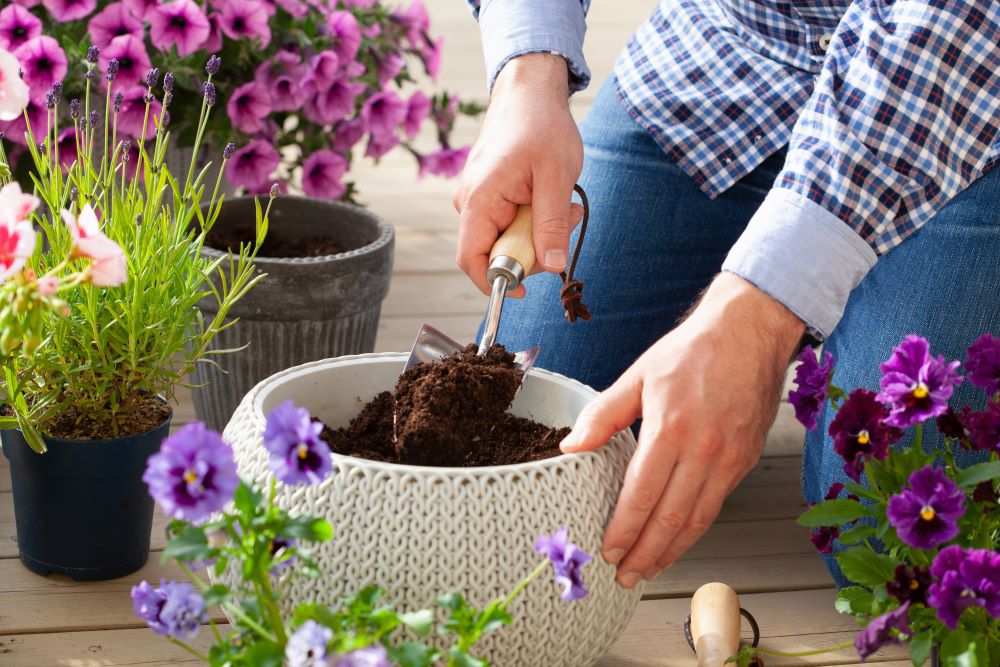
Soil is the foundation that provides nutrients to the roots, so it’s important to choose the best type of soil for your flowers and plants. You can easily find any potting soil mix that you can use for most of your gardening containers. However, keep in mind that not every potting soil is made the same. You’ll want to choose a high quality soil mix to assure the best growth and longevity.
Here are a couple things to keep in mind when choosing a potting soil:
- Specific Plant Needs: Research the amount of moisture and pH level that your plant needs and pick a soil accordingly.
- Water Retention: If the plant is going to be in full sunlight, opt for a medium weight soil that retains water. However, if the plant is in indirect sunlight or partial shade, you can go for a lighter weight because they won’t lose water as quickly.
You’ll also want to fill your containers with as much soil as possible. If you’ve never done container gardening before, you’ll be surprised to realize that you’ll need more soil than you might think. It’s important to use a hearty amount of soil for the best plant growth. Make sure to fill the container with soil about a half inch below the rim to allow plants to grow at their proper height. Keep in mind that you also don’t want to add an excessive amount of soil either because it’ll fall over the top when watering.
4. Care For Your Container Garden With Fertilizer & Sunlight
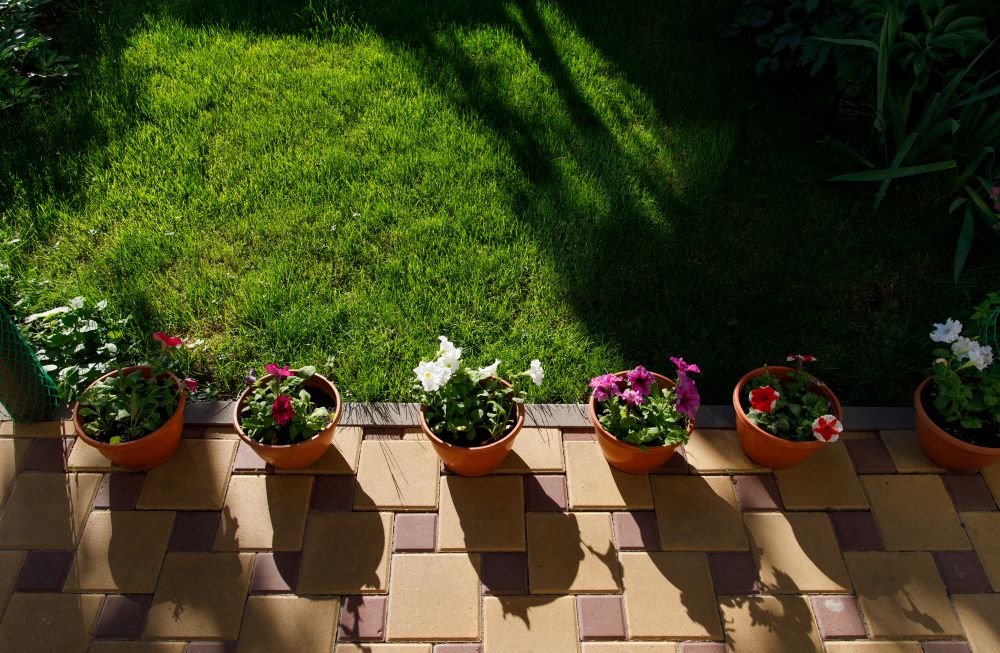
While potting soil will help you with your basic container gardening needs, it’s also important to add fertilizer into the mix. Many potting soils don’t include the proper nutrients that flowers and plants need to grow strong, so adding fertilizer will provide those nutrients.
A simple way to fertilize your container plants is to mix slow-release fertilizer pellets into your potting soil. Many types of these pellets will feed your plants and flowers for about 60 days; however, there are various brands and types that provide nutrients for a longer period of time. Make sure to research and double check on the which types of pellets will work best for your plants.
When your plants start growing, you’ll need to supplement the pellets with liquid fertilizer. This can easily be dissolved in water and then poured into the container to feed your plants. As always, be sure to follow directions for specific types of plants and specific types of liquid fertilizer. Keep in mind the size of your container as well because different sized containers will require different amounts of liquid fertilizer.
In addition to providing nutrients with fertilizer, you’ll also need to give your container plants a sufficient amount of sunlight. Amount of sunlight will vary between different plants and flowers. However, you can keep these three basic tips in mind when planning the location of your containers.
Amount Of Daily Sunlight Needed For Container Gardening
- Plants that require full sun: minimum of six to eight hours of direct sunlight daily
- Plants that require partial sun or partial shade: four to six hours of sunlight daily
- Plants that require full shade: three hours of sunlight daily
5. Keep Up With Container Gardening Maintenance
Once you establish your container garden, the work isn’t over. Keeping up with care and maintenance will help you continue to grow healthy flowers and plants. While pots and planters need consistent care, it doesn’t have to be difficult or time consuming depending on the types of plants you have. Consider the amount of time you have to dedicate to your plants before choosing which ones you want.
Certain types of plants and flowers will require some additional maintenance and care tips; however, these are the main care steps to keep in mind for most container garden plants:
1. Water Your Container Plants Frequently
You’ll want to keep the soil consistently moist, especially during periods of extreme heat. Check the soil by placing your finger about an inch into the container – if it’s dry, you know it’s time to water. However, your containers will typically need to be watered once or twice per day.
2. Fertilize Your Pots & Planters Often
As mentioned in one of the other container gardening tips in this article, it’s important to keep your container plants fertilized. Watering will wash out the nutrients over time, so it’s crucial to stay on top of fertilizing as your plants grow.
3. Remove Dead Flowers As You See Them
Another important container gardening maintenance step is to remove dead and damaged flowers as you see them. Pinch the dead flowers off the stems to encourage new flower growth. You’ll also want to prune any long stems or branches to keep your plant healthy.
4. Freshen Up Your Garden Containers As The Seasons Change
If you’re planning on keeping your container garden going throughout the various seasons, you’ll want to keep up with swapping out your plants and flowers for new ones. Once certain types of plants are out of season or past their prime, you can replace them with new ones that will thrive in the current season.
Now that you’ve learned some container gardening tips, visit our Garden Center for even more inspiration! Find planters and containers, live plants and flowers, gardening tools and decorations, and much more to make your outdoor space look beautiful.


